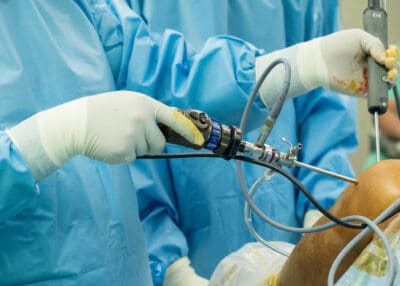Arthroscopic Shoulder Stabilization Surgeon

Are you an athlete who participates in a sport that involve repetitive overhead motions? If so, you may be at risk of developing shoulder instability which requires surgical repair. Arthroscopic shoulder surgeon, Doctor Matthew Provencher provides diagnosis and both surgical and nonsurgical treatment options for patients in Vail, Aspen, Colorado Springs, and the Denver, Colorado area who are experiencing shoulder instability. Contact Dr. Provencher’s team today!
What is shoulder instability?
Shoulder instability is the condition in which the soft-tissue restraints of the shoulder (tendons, ligaments, and labrum) can no longer provide stability to the shoulder joint. Of the four joints within the shoulder complex, the glenohumeral joint, formed by the articulation of the humeral head (upper arm bone) into the glenoid socket of the scapula (shoulder blade), is affected by shoulder instability. This condition is often the result of a blunt force trauma to the shoulder that causes the humeral head to separate from the glenoid socket. In the event of joint separation, the ligaments and tendons are stretched or torn, either partially or completely, away from their attachment site. Individuals that participate in sports-related activities involving repetitive overhead motions, commonly seen in swimming, volleyball, or baseball, are most at risk of developing shoulder instability. Dr. Matthew T. Provencher, orthopedic shoulder doctor, treats patients in Vail, Aspen, Colorado Springs, and the Denver, Colorado area who have experienced shoulder instability and are in need of surgical repair.
What is arthroscopic stabilization for shoulder instability?
Arthroscopic stabilization for shoulder instability is a minimally invasive surgical procedure that aims to restabilize the shoulder joint. Patients and surgeons alike favor this surgical approach due to the use of smaller incisions and the shortened recovery period. Prior to the procedure, a nerve block is administered to the shoulder for anesthesia. When stable, Dr. Provencher inserts a small camera (arthroscope) to methodically examine the muscles, ligaments, and tendons of the shoulder joint. The area of soft tissue damage is identified, and specialized surgical instruments are utilized to excise and remove the damaged tissue fragments. The healthy ligaments that remain are fastened to the glenoid portion of the scapula with special surgical anchors that are secured within the bone. These surgical anchors also serve to realign and secure the glenohumeral joint back to its correct anatomical position.

On occasion, the shoulder joint may need to be restabilized by open surgery. Dr. Provencher may recommend this surgical technique over an arthroscopic repair in the event that patients experience a large bone loss as a result of dislocation, chronic shoulder instability, or the shoulder joint failed to be reduced. Open surgery involves a slightly larger incision for Dr. Provencher to visualize the entire shoulder while completing the necessary repairs.
What is a capsular shift?
A capsular shift is another effective surgical technique that aims to improve shoulder instability by tightening the shoulder joint capsule. This open surgical procedure involves the careful incision of the subscapularis muscle portion of the rotator cuff to enable access to the shoulder capsule. Dr. Provencher separates the capsule and subsequently pulls the lower portion up and the upper portion is pulled down to overlap each other. These overlapping tissues are then sutured together, similar to a tailor, to decrease the volume of the shoulder capsule.
What is the recovery period like after arthroscopic stabilization for shoulder instability?
The recovery period following successful stabilization of the shoulder is largely dependent upon the surgical technique performed by Dr. Provencher. Although the minimally invasive arthroscopic method does reduce the recovery time, the ligaments and tendons still take the same amount of time to heal. Most patients can expect a return to normal daily activities in 4 to 6 months, with a year or more of continued improvement. Overall, patients in the Vail, Aspen, Colorado Springs, and the Denver, Colorado area can expect the following:
- Immediate immobilization of the shoulder after surgery and continue for approximately 3 to 6 weeks.
- A combination of rest, ice, and non-steroidal anti-inflammatory medications (NSAIDs) are used to control the pain and reduce inflammation. If necessary, stronger pain medications can be prescribed by Dr. Provencher and taken as directed.
- The key to a successful recovery following shoulder stabilization is the active participation and completion of the physical rehabilitation program set forth by Dr. Provencher. This physical therapy program will focus on restoring strength and improving shoulder range of motion.
For more information on arthroscopic stabilization for shoulder instability, or to discuss your shoulder instability treatment options, please contact the office of Matthew T. Provencher, MD, orthopedic shoulder doctor at The Steadman Clinic, serving Vail, Aspen, Colorado Springs, and the Denver, Colorado area.